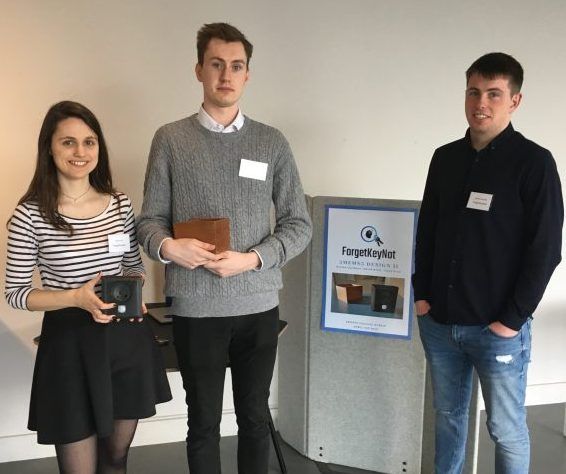Students showcase smart home technology of the future
Posted on: 04 April 2019
Earlier this week, third-year Engineering with Management students from Trinity unveiled innovative prototypes of the smart-home technology of the future at a special event held in Science Gallery Dublin. Over 80 people, including students, faculty, and representatives from industry, recruitment companies and governmental organisations, attended.
The showcase was the conclusion of eight months’ work, where teams, comprising 3-4 students, were tasked with developing product concepts in response to a real-world design prompt. This year, the prompt was to “develop a smart technology for the home that addresses a problem”.
In developing concepts, teams were required to first conduct product benchmarking as well as detailed patent and standard reviews. After drafting a product design specification, which identified a specific problem to be addressed, target demographic and product criteria (size, cost, weight, etc.), teams then formulated several product concepts.
These concepts were subjected to a systematic evaluation process, where a final concept was chosen. With the final concept chosen, a proof of concept prototype was developed, followed by a higher resolution prototype which was ultimately demonstrated at the project showcase.
The prototypes
Pill-O-Clock (Instagram: pilloclock)
Pill-O-Clock is an automated pill dispenser to help people better manage their medication schedules. This innovation would be especially useful for older adults with memory problems, or those required to manage often complex medication schedules.

The device comprises three (or more) chambers where tablets can be stored securely, and provides notifications to users through audio or via smart phone/watch alerts. Using face recognition algorithms, the team integrated an AI functionality so the machine would only dispense medications to the correct user.
DeafBell (Instagram: deafbell)
DeafBell enables alerts and notifications to be communicated reliably and discretely to people with hearing impairments. The team showcased a prototype wristband that wirelessly connects to a range of smart home applications, including existing doorbell technology.

Using a flashing LED and vibrating motor inside the bracelet, the device alerts the user when the doorbell is pressed and can be configured for a range of other applications with relative ease.
Senseable (Instagram: senseable)
Senseable is an object-detecting belt that helps people with visual impairments navigate more efficiently, possibly without the need for a cane. It presents a significant performance improvement, and offers a more discreet way for visually impaired people to navigate.

The belt is equipped with eight ultrasonic sensors that can pick up nearby objects. Once detected, their relative location is communicated to the user through a vibrating motor. Despite its complexity, its design should make it highly affordable to users.
Guardian Angels (Instagram: guardianangels)
Guardian Angels created a smart speaker system that can detect users in the vicinity, and selectively provide alerts or notifications. With several speakers installed throughout a house, it would be possible for household appliances to communicate with users, even when they are not in the same room. For example, if a user forgot to turn off the cooker, a sensor in the cooker could alert the speaker system, which could locate the user and communicate the message.

The prototype comprised a module containing a wirelessly operated speaker connected, a PIR sensor, and a person-detecting vision system that could identify humans in an image. The vision system achieved high performance, using an algorithm developed using deep learning.
Forget Key Not (Instagram: forgetkeynot)
Forget Key Not makes it easier for people to locate items in the home, and helps reduce the likelihood of forgetting them when they leave the house. The team demonstrated a system where users place important items like phones, wallets, and keys in one of several small baskets located throughout the home. Each basket detects its contents, using RFID technology, and alerts the user to the location of the item when requested.

The system also comprises a notification system, which triggers an audio alert to the users when they open the front door, ensuring they have not forgotten something important.
Assistant Professor in Trinity’s School of Engineering, Conor McGinn, lecturer of the Engineering with Management module, said: The overall goal of the course is to empower students to apply their creativity and technical skills to create products that address real problems and have the potential to make real impact.
This was an especially talented and driven group of students, and given the opportunities, I think they will go on to apply their skills in very positive ways for the betterment of the society.
With the help of Science Gallery Dublin, who partnered with us in organising the event, we have been able to give the students a platform to showcase their skills and ingenuity to the public as well as invite attendees from industry, government agencies and the broader college community.
